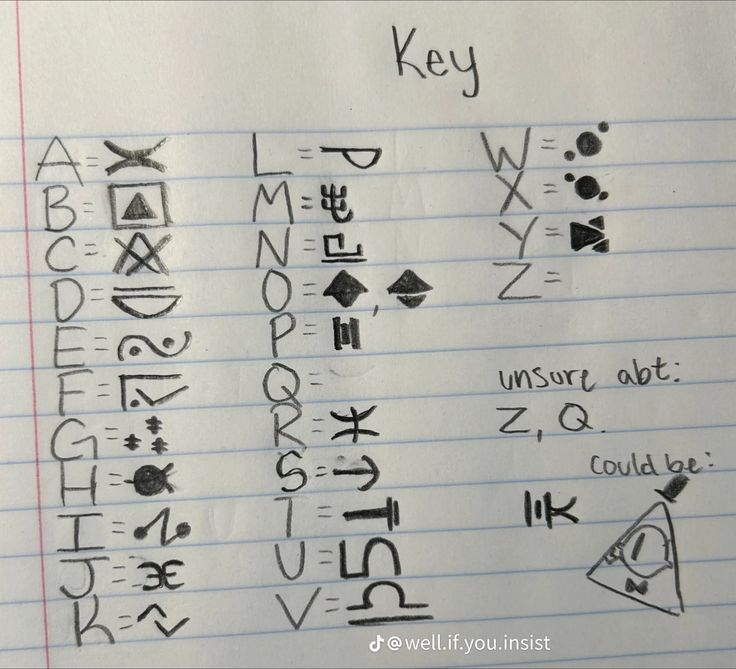In the whimsical and enigmatic world of “Gravity Falls,” the character Bill Cipher stands as an iconic figure synonymous with chaos and intrigue. As a powerful demon with a penchant for manipulation, Bill embodies a plethora of cryptographic symbols and codes that fans have tirelessly sought to unravel. The “Book of Bill,” often lauded for its complex language and intricate illustrations, serves as a pivotal text that aids in decoding the cipher’s myriad secrets. Through an exploration of this unique tome, readers can expect to embark on a thrilling journey of discovery, filled with various types of content that enhance both their understanding and appreciation of this cryptic character.
Firstly, delving into the visual aesthetics of the Book of Bill is paramount. The book is replete with illustrations that are not only eye-catching but rich in symbolism. The geometric shapes and surreal imagery that accompany Bill’s writings offer a striking representation of his chaotic nature. This visual exuberance is instrumental in providing insights into the narrative themes of “Gravity Falls.” The pages depict bizarre creatures, bizarre landscapes, and esoteric symbolism. Each illustration is designed meticulously to evoke a sense of foreboding, mirroring Bill’s own nefarious intentions. Readers can expect to analyze these images as they relate to the overarching mythology of the series, revealing deeper connections between Bill Cipher and the world around him.
Secondly, the linguistic challenges presented by the Book of Bill merit considerable attention. The text utilizes an array of cryptographic codes, riddles, and ciphers that are intended to obfuscate rather than clarify. Thus, analyzing the linguistic components becomes an essential activity for enthusiasts hoping to decode Bill’s messages. The various ciphers include simple substitution methods, advanced cryptograms, and even allusions to more obscure languages. Engaging with these linguistic puzzles enables readers to not only decode the messages but also appreciate the artistry involved in constructing such perplexing texts.
Moreover, the narrative structure of the Book of Bill deserves thorough examination. The compilation of writings reflects a non-linear storytelling style, echoing the fragmented nature of Bill Cipher’s persona. Fans can dissect the organizational framework of the text, exploring how the concepts of time, chaos, and reality are woven together to create a sense of dread and urgency. Each entry serves as a piece in a larger puzzle, presenting content that oscillates between whimsical and sinister, enthralling readers as they uncover the sinister context behind each passage.
An integral aspect of the Book of Bill is its intertextuality with other elements of “Gravity Falls.” References to recurring themes, such as the battle between good and evil, the duality of human nature, and the quest for knowledge, underline the philosophical musings embedded within Bill’s code. Understanding these connections elevates the reading experience, allowing fans to appreciate the broader narrative that unfolds throughout the series. Key elements such as the journals of Stanford Pines provide a counterpoint to Bill’s chaos, as they strive to document and contain the supernatural occurrences within the town of Gravity Falls. This relationship can prove enlightening for readers aiming to paint a holistic picture of the series’ narrative landscape.
As readers delve deeper into the Book of Bill, they will encounter a diverse array of themes, such as the pursuit of power and the consequences of unchecked ambition. Bill Cipher embodies the archetypal trickster, reveling in the discord he creates while also critiquing the repercussions of human folly. Exploring these themes can be both rewarding and thought-provoking, allowing readers to reflect on their own lives and societal structures. By inviting readers to confront existential dilemmas, the Book of Bill transcends mere entertainment, positioning itself as a source of philosophical inquiry.
Additionally, the coding techniques presented in the Book of Bill serve as a practical guide for aspiring cryptographers. The various ciphers employed are not simply for literary decoration; they provide an authentic experience for readers who wish to hone their cryptographic skills. From simple substitution ciphers to Vigenère ciphers, readers can engage in practical exercises that challenge their analytical thinking and problem-solving abilities. This pragmatic approach to decoding not only enhances engagement but also fosters a deeper understanding of cryptography’s role in literature and storytelling.
At the intersection of decoding and creativity lies the concept of fan engagement. The mysteries contained within the Book of Bill have incited a vibrant community of fans, many of whom have taken to creating their own interpretations, theories, and artworks inspired by the text. This coalescence of creativity and cryptography engenders a dynamic dialogue, enriching the experience for both creators and consumers. Readers can explore fan theories, interpretations, and artworks, culminating in a collaborative effort to expand the narrative universe of “Gravity Falls.”
In conclusion, the Book of Bill represents a rich tapestry woven from stunning visuals, cryptic language, complex narratives, and philosophical themes. Readers can anticipate an intellectual expedition filled with opportunities for analysis, reflection, and collaboration. From the intricacies of Bill Cipher’s codes to the community’s fervor for interpretation, decoding the Book of Bill elevates the experience of “Gravity Falls” into a multifaceted exploration of creativity and chaos. As the pages are turned, the secrets hidden within await discovery, beckoning all who dare to enter the mysterious realm of Bill Cipher.








Leave a Comment